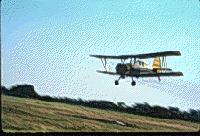
Kentucky Pest News mailings would normally switch to First Class mail at this time of the year. In compliance with a recent administrative decision prompted by postage costs, all departmental mailings with numbers of 200 or greater must be sent using Bulk Rate postage. With 1,300 subscribers, this will affect the KPN. Much of the information in this free newsletter is perishable and delays in bulk mail delivery may make recommendations or information in the articles obsolete by the time they are received.
There are two options to continue to get the
information in a timely manner. 1) Electronic
subscription The KPN is automatically sent by
email on the day it is written. If you have an
email account and would like to get the
newsletter in a timely manner, follow these
steps:
Send a message exactly as follows:
subscribe pestnews
end
Key Enter to create at least one blank line and
send
to: majordomo194@ca.uky.edu
You will be placed on the mailing list and will receive the issues by email immediately as they are posted, usually on Monday afternoons.
The Internet version usually is posted by noon on Tuesdays.
MAILING LIST UPDATE
Look for a form in the hard copy issue that must be
filled out and returned so that you will
continue to receive the KPN by mail.
Most readers who work with perennial ryegrass are aware of the emergence of gray leaf spot in the past decade as one of the most destructive turfgrass diseases known. Those of you with experience against gray leaf spot know how rapid and destructive the disease can be.
Fungicides remain our first line of defense against gray leaf spot, because all commercial varieties are susceptible and cultural practices can provide only limited control under high disease pressure. Because of the high cost of fungicides, many turf managers are interested in ways to use these important products more wisely and economically. My opinion is that at this time, there is no better way to optimize the use of fungicides than to scout your own swards for the disease and to microscopically verify the presence of the causal fungus in diseased tissues. Experienced turfgrass pathologists agree that microscopic verification is important because it is often not possible to positively identify this disease based on symptoms alone.
Proper scouting can help you decide:
The University of Kentucky Cooperative Extension Service will hold a workshop for turf managers and other interested professionals on microscopic identification of gray leaf spot of perennial ryegrass. Details are as follows:
Date & Time: June 20, 2001, from 1:00-5:00
Location: The University of Kentucky campus in Lexington
Cost: $900, Registration must be received by
Monday, May 7
While the cost may seem high at first glance, registrants
will actually be getting a lot for their money. Each
registrant will receive a high-quality compound binocular
light microscope (40-1000X magnifications, with halogen
illumination and high contrast lenses), which you will
learn to use during the workshop. In addition, each
registrant will receive dissecting kits, lense cleaning
supplies and other laboratory materials, a notebook
including color images, a 2X desk magnifier with built-in
illumination, and a field magnifying glass.
Learning Objective: As a result of this workshop, you will be able to detect Pyricularia grisea (the causal fungus of gray leaf spot) in diseased turfgrass tissue. This skill will provide the foundation for a scouting and monitoring program for gray leaf spot.
If interested in attending, please contact Pat Yancey
at
pyancey@pop.uky.edu
pyancey@pop.uky.edu for a registration form.
Registration is limited in order to provide a high-
quality learning experience for those who attend.
Interested Kentuckians should act soon, since out-
of-state registrants will be accepted on April 20.
Registration and payment must be received by
Monday, May 7.
Frankfort, KY If it sounds too good to be true, chances are, it is. That's according to officials in the Kentucky Department of Agriculture who say several vendors usually appear across the Bluegrass State about this time every year, selling ineffective chemicals at cut-rate prices.
"Each spring, we in the Department receive many complaints from home gardeners, farmers, and others who purchase cheap but ineffective chemicals over the telephone or on the Internet," said Billy Ray Smith, Commissioner of Agriculture. "The sellers of these products usually claim they're comparable to well- known national brands, and for some folks, the cheaper prices are hard to resist."
Pressure tactics are frequently used by sellers of such chemicals. "If the seller tells you to buy his product now or the deal will be gone forever, that's a strong indication that his product is no good," said John McCauley, Director of the Division of Pesticide Regulation.
The KDA's Ken Franks works with licensed pesticide retailers throughout Kentucky and says if you are considering buying a chemical product over the phone or on the Internet, you should ask the seller several questions.
--Ask for the products' EPA registration number.
--Call the KDA to ensure the product is registered for
use in Kentucky.
--Ask for the product's active ingredients and record
the percentages of each.
--Ask how many square feet or acres the product will
cover.
--Request complete directions for use of the product.
--Ask for the company's name, address, and
telephone number.
--Compare the product to a similar one offered by
your local retailer.
--Ask if the seller has a license to sell in Kentucky and
ask for his name and license number.
--Keep a record of all of this information.
"You should never buy a product that requires cash upon delivery," Franks said. "Sometimes these vendors will send you the product whether you ordered it or not, so be careful about who you talk with."
For additional information contact Ken Franks at (502) 564-7274 or
ken.franks@kyagr.com.

Most herbicide labels discuss mixing instructions largely because this process can impact the effectiveness of the spray mixture. It was recognized several years ago that the sequence of mixing herbicides together as tank mix combinations can be important, particularly when different formulations are included in the mixture. The general rule for adding materials to the spray tank is to start with wettable powders first, followed by flowables, emulsifiable concentrates, and water soluble liquids. Surfactants or oil concentrates are usually added last. The specific sequence may vary depending on products used.
The 'jar test' method that is described on may product labels may help determine physical signs of compatibility of products but will not indicate the potential for antagonism as it relates to crop injury or weed control.
The use of nitrogen fertilizers such as 28% nitrogen, 10-34-0, or ammonium sulfate as additives can sometimes impact effectiveness of spray mixtures. Ammonium sulfate as well as 28% liquid nitrogen may reduce activity of Accent Gold, whereas, 10-34- 0 is the preferred source of nitrogen as an additive with this herbicide. The sequence in which nitrogen fertilizers are added in the spray mixtures may also impact the activity of certain herbicides. For example, ammonium sulfate should be included first when it is used with Roundup Ultra.
Some products are not very stable in water over time and should be sprayed soon after they are mixed. This is especially true of many of the sulfonylurea herbicides. In order to avoid product degradation, Accent Gold should be applied within 4 hours after mixing compared with 24 hours for Accent.
Consulting the labels of all materials involved in a spray mixture may help avoid problems with mixing, crop injury, or weed control.

Regular inspections, preferably twice a week, will help to catch important pest problems early and keep seedling losses to a minimum. Early problems have included pillbugs and small ground beetles but cutworms and shore fly problems will not be far behind.
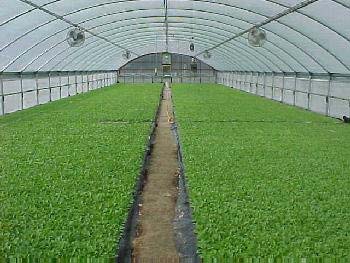 Pillbugs and sowbugs, the small gray creatures that roll
into a ball when disturbed, need humid air to survive.
Conditions around float beds are ideal for them and they
can crawl in trays and burrow in the growing media.
They are scavengers but may feed on small plant roots
and uproot seedlings. Control with insecticides can be
erratic. Sevin bait, scattered around the perimeter of the
float area, or greenhouse, should be more attractive and
may help to reduce their numbers. Keeping a clipped,
clear border around the area will discourage movement of
pillbugs into the float area. They do not like to move in
exposed, dry areas.
Pillbugs and sowbugs, the small gray creatures that roll
into a ball when disturbed, need humid air to survive.
Conditions around float beds are ideal for them and they
can crawl in trays and burrow in the growing media.
They are scavengers but may feed on small plant roots
and uproot seedlings. Control with insecticides can be
erratic. Sevin bait, scattered around the perimeter of the
float area, or greenhouse, should be more attractive and
may help to reduce their numbers. Keeping a clipped,
clear border around the area will discourage movement of
pillbugs into the float area. They do not like to move in
exposed, dry areas.
Small ground beetles have been found in some Pulaski county float plants. These ½" long dark beetles are causing most of their damage by digging into the media. They may be attracted to the area by outdoor lights and dig into the soft media to hide during the day. As with pillbugs, the hard body covering reduces the effect of an insecticide application, even with direct application to the insect. Elimination of outdoor lighting and exclusion screens should help to keep them out.
Variegated cutworms are dark brown to black caterpillars that lighten to a dingy gray as they grow. The distinctive feature is a single row of small light spots (1 per body segment) down the center of the back. Variegated cutworms feed on seedling leaves and burrow down into the media when not feeding. They are among the largest of our cutworms, reaching a length of just over 1-1/2 inches when full-grown. Most of the feeding is done in the last stages of the 3-1/2 week larval period so a lot of damage can occur over a short period of time.
Watch for rounded holes in the leaves and search around damaged plants for the cutworms. Moths lay clusters of about 60 eggs on low-growing plants. This means that there will be "hot spots" on particular trays or groups of trays, rather than a general widespread infestation over the entire area. A single moth can enter the greenhouse or float area and lay several clusters of eggs. Some outdoor lighting systems may attract moths to the area and subsequently lead to infestation. Usually the moths are active at night and rest in hidden areas during the day.
Shore flies are showing up in samples now. Shore fly larvae are small, dingy gray, headless creatures with a short, forked tail. They feed on algae growing on the media surface but also can scrape holes in plant leaves. Damage is usually limited to leaves in contact with the media, however, the larvae can tunnel into plant stems. The adults are small, clear-winged gnats that can be seen crawling over the plants and media.
Variegated cutworms and exposed shore fly larvae and adults can be controlled by foliar sprays of Orthene. Larvae inside stems are not affected by the treatment.
Waterfleas are among the more unusual things that can be found in float water. About the size, shape, and color of an alfalfa seed, these small creatures zip along in the water and can be abundant enough to make it seem alive with them. They pose no threat to tobacco plants. Waterfleas feed on small particles in the water and do not damage tobacco root systems.
For more information about pests, visit "Insect Management Recommendations".
For the latest blue mold status, check the KY Blue Mold Warning System.
![]() http://www.uky.edu/Agriculture/kpn/kyblue/kyblue.htm
http://www.uky.edu/Agriculture/kpn/kyblue/kyblue.htm

It's a relatively common scenario. Early warm temperatures push degree day totals along rapidly. We reach the total that signals the time to look for early tip feeding damage (190), then we get a "weather correction" in the form of a cold snap.
What is the effect on alfalfa weevils? Generally, not much. Development will stop when temperatures fall below 48º F but few, if any, are killed by the cold we have experienced. As early season insects, they are equipped to withstand some erratic spring weather.
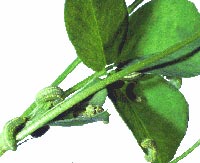 The effect on the alfalfa plant, however, is a
different story. Freeze damage may, in effect,
"shorten" alfalfa plants in terms of management
decisions. Our best guidelines are based upon plant
height, current degree day accumulation, and
numbers of larvae per 30 stems. Use the "live stem"
height" instead of total plant height if cold injury is
a factor in the field. This will lower the number of
larvae that can be tolerated and help to compensate
for weather-related damage.
The effect on the alfalfa plant, however, is a
different story. Freeze damage may, in effect,
"shorten" alfalfa plants in terms of management
decisions. Our best guidelines are based upon plant
height, current degree day accumulation, and
numbers of larvae per 30 stems. Use the "live stem"
height" instead of total plant height if cold injury is
a factor in the field. This will lower the number of
larvae that can be tolerated and help to compensate
for weather-related damage.
See Insect Recommendations for more alfalfa pest recommendations.
Pea aphids and spittlebugs are common spring insects on alfalfa. These sap feeders can be abundant, especially during cool, wet springs but rarely have a significant impact on first cutting yield or quality. If anything, they provide some early season food for beneficials and help the useful insects to increase in number.
 The pea aphid does best during cooler periods and
occurs on alfalfa in the spring and again in the fall.
These light green aphids live in clusters on plant
stems and terminal buds. Yellowed, wilted foliage,
and an average of 50 or more aphids per stem
would be needed to justify a control measure. If
many aphids are present, you can often see bloated,
straw-colored aphid mummies that have been
parasitized by a tiny wasp. The wasps and hotter
weather will reduce aphid numbers naturally and
an insecticide application will not be needed.
The pea aphid does best during cooler periods and
occurs on alfalfa in the spring and again in the fall.
These light green aphids live in clusters on plant
stems and terminal buds. Yellowed, wilted foliage,
and an average of 50 or more aphids per stem
would be needed to justify a control measure. If
many aphids are present, you can often see bloated,
straw-colored aphid mummies that have been
parasitized by a tiny wasp. The wasps and hotter
weather will reduce aphid numbers naturally and
an insecticide application will not be needed.
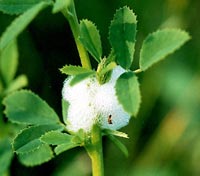 Spittlebugs overwinter as eggs inserted between the
sheath and stem of grasses so they are most
common in mixed grass and alfalfa stands. The
nymphs, or immature stages, excrete a frothy liquid
that covers them completely, providing protection
from drying out and may provide some protection
against natural enemies that prefer to look for food
that isn't covered with spit. Several spittlebugs per
stem are generally necessary to justify concern. Even
then, the spittle probably provides protection
against and insecticide spray.
Spittlebugs overwinter as eggs inserted between the
sheath and stem of grasses so they are most
common in mixed grass and alfalfa stands. The
nymphs, or immature stages, excrete a frothy liquid
that covers them completely, providing protection
from drying out and may provide some protection
against natural enemies that prefer to look for food
that isn't covered with spit. Several spittlebugs per
stem are generally necessary to justify concern. Even
then, the spittle probably provides protection
against and insecticide spray.
See Insect Recommendations for more alfalfa pest recommendations.

 Currently, all is quiet on the wheat disease "front".
We have had a few virus samples and a couple
confirmations of barley yellow dwarf. However, as
of this writing, there is no evidence that any wheat
virus will be a serious problem this year. This
proclamation may be a bit premature because of the
delayed wheat development due a cold March, but
things are looking very favorable, nonetheless.
Currently, all is quiet on the wheat disease "front".
We have had a few virus samples and a couple
confirmations of barley yellow dwarf. However, as
of this writing, there is no evidence that any wheat
virus will be a serious problem this year. This
proclamation may be a bit premature because of the
delayed wheat development due a cold March, but
things are looking very favorable, nonetheless.
Fungal diseases are also very minimal at the present time. I have seen some Septoria leaf blotch associated with winter-killed lower leaves, but this is normal. Generally, powdery mildew levels are very low. Leaf rust is at very low levels in Texas and Louisiana, which is unusual for this time of the year. Generally, this indicates that leaf rust will not be a serious problem in the mid-south this season. As you are probably aware, most of the leaf rust inoculum blows in from the southwest, so the lack of disease in the lower mid-south is a very important observation for Kentucky growers. Similarly, more northern states use Kentucky as an indicator of what to expect in their respective states. Leaf rust is one of the few wheat diseases that can be "tracked" in advance of the problem developing locally.
As I indicated earlier in this article, the wheat stage of development is not as advanced for April 16 as is usual. However, the recent warm weather has really caused the wheat to "jump". I suspect the time between growth stages will be substantially compressed and this is likely to affect the disease status of the crop. How this compression affects disease development is uncertain at present.
I will immediately inform you of any new and/or
unusual disease situations as they develop.
 The plant activator Actigard 50 WP, marketed by
Syngenta, was labeled late last season for disease
control in selected leafy vegetables, tomatoes, and
tobacco. I will provide more details on the tobacco
use in a future article, because the approach is very
different for tomatoes and tobacco. Actigard
contains acibenzolar-S-methyl which has no
significant direct activity against the target
pathogens. Instead, the active ingredient gives
control by inducing (triggering) a series of natural
chemical reactions in the treated plant that activate
the plant's own resistance mechanisms - called the
SAR (systemic activated resistance). Consequently,
disease control is normally not obtained until four
or five days after the application is made and there
may be other desirable and undesirable
physiological changes that occur under certain
conditions in the treated plant.
The plant activator Actigard 50 WP, marketed by
Syngenta, was labeled late last season for disease
control in selected leafy vegetables, tomatoes, and
tobacco. I will provide more details on the tobacco
use in a future article, because the approach is very
different for tomatoes and tobacco. Actigard
contains acibenzolar-S-methyl which has no
significant direct activity against the target
pathogens. Instead, the active ingredient gives
control by inducing (triggering) a series of natural
chemical reactions in the treated plant that activate
the plant's own resistance mechanisms - called the
SAR (systemic activated resistance). Consequently,
disease control is normally not obtained until four
or five days after the application is made and there
may be other desirable and undesirable
physiological changes that occur under certain
conditions in the treated plant.
The efficacy of Actigard in controlling bacterial leaf spot diseases in tomatoes has been well demonstrated in the major tomato growing regions of the world.
Actigard is labeled on tomatoes for six, weekly, sequential applications at the rate of 1/3, 1/2 and 3/4 oz./acre to control bacterial spot and bacterial speck. The low rate is to be used early in the season while plants are small (within two weeks of transplanting stage), the ½-rate during the 3rd and 4th weeks, and the ¾-rate in the 5th to 8th weeks. The preharvest interval is 14 days and the re-entry interval is 12 hours. Actigard is compatible with most insecticides and fungicides used on tomatoes.
Thorough coverage is necessary in tomatoes to provide maximum disease control. The label rates are made with the assumptions that a dilute spray volume is being used, starting out at 30 gallons/acre of spray volume on small plants and increasing the volume at each application until 100 gallons per acre is being used on fully grown tomato plants. To avoid phytotoxicity problems, it is very important to calculate and measure carefully , and do not apply Actigard on less than a 7-day interval. Spray equipment needs to be adjusted to apply a uniform coverage at the correct rates. For example, last fall, I observed damage from an application where the nozzle over the row was delivering chemical at twice the rate as the drop- nozzles between the rows.
In the absence of disease, Actiguard applications may reduce yields. There has been yield reduction with the use of Actigard in some trials - and the label clearly carries that advisory. The research community still does not have a clear understanding of when and how the yield reduction occurs. Furthermore, we have very limited experience with this chemical on tomato production in Kentucky. Our state has abundant experience with bacterial spot and speck, however, and the losses these two diseases can cause in wet seasons can be great, warranting the weekly applications of fixed copper plus an EBDC-containing fungicide. Moreover, these two diseases are becoming increasingly important in commercial tomato production, with new strains emerging, including copper-resistant strains. Consequently, each grower will need to carefully weigh the risk and benefit involved. It seems prudent for growers to test this product on only a small portion of the crop this year in Kentucky to learn more about how well it will fit into each grower's production system. I urge County Extension Agents to work closely with growers during this evaluation period.
Since many of Kentucky's vegetable growers also have other vegetable crops, it will be very important that Actigard not be applied on unlabeled vegetable crops, accidently or on purpose. The results could be very detrimental, so the potential for this error to happen on each farm should be taken seriously. Although label expansion to other crops will likely occur with time, many vegetable crops can be severely injured from Actigard. For example, even closely related crops such as peppers are damaged severely by Actigard, a crop that could benefit significantly from another bacterial disease control.

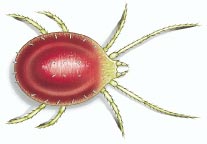 Clover mites are accidental invaders that can be a
temporary nuisance during the early spring. These
very small, reddish brown creatures appear only as
moving dark spots to the naked eye. Sheer numbers,
plus the resulting red-brown stain left behind if they
are crushed, make them unwelcome visitors. Clover
mites are not blood feeders and will not harm
people or pets, nor will they infest household
products. Once inside a home or building they will
soon die.
Clover mites are accidental invaders that can be a
temporary nuisance during the early spring. These
very small, reddish brown creatures appear only as
moving dark spots to the naked eye. Sheer numbers,
plus the resulting red-brown stain left behind if they
are crushed, make them unwelcome visitors. Clover
mites are not blood feeders and will not harm
people or pets, nor will they infest household
products. Once inside a home or building they will
soon die.
Clover mites feed on clover and grasses. They can be especially abundant in the heavy, succulent growth of well-fertilized lawns. They usually enter a home around windows or doors so they are usually seen crawling along sills or thresholds.
A soapy rag or wet sponge can be used to clean mites off of surfaces. Wipe carefully to avoid crushing the mites and causing stains. The crevice tool of a vacuum cleaner may also be used to pick up mites. Rely on non-chemical control indoors. Do not apply insecticides to kitchen counters or other interior surfaces.
There is an increased potential for invading structures when grass extends up to the foundation. A plant bed or open area will provide a barrier that will stop many mites and provide a long term solution to persistent problems. Avoid overfertilizing lawns. This creates situations that are ideal for mites to increase to tremendous numbers.
Heat unit accumulations are triggering the emergence and appearance of several key horticultural pests. If control is warranted, the time for action is now when pest life stages are most vulnerable. These timely recommendations have been made possible by the phenological management schedule developed by the UK Horticultural Entomology Research Lab. A copy of the table can be found in extension publication ENT- 66, Timing Control Actions for Landscape Insect Pests.
Eastern tent caterpillar - It's been quite a spring for tent caterpillars. Although this defoliator has been active for some time, many householders are only now spotting them in their prized crabapple or cherry tree. The tent-like nests constructed of webbing are usually formed at a branch fork. Larvae venture out from the nest during the day to feed on new foliage. The eastern tent caterpillar favors wild cherry, apple and crabapple but will also attack peach, pear, plum, hawthorn and some shade trees. Trees sometimes contain several nests and can be completely defoliated in 2-3 weeks.
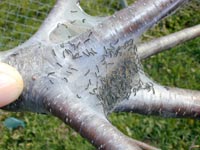 Control is best accomplished when webs are first
noticed and the larvae are small. If nests are within
reach, they can be removed with a stick, broom, or
pruning shears. This should be done in the evening,
when the larvae are inside the nest. Insecticidal
sprays are also effective. Registered products
include Bt (Bacillus thuringiensis), Sevin, Dursban,
and synthetic pyrethroids, e.g. Scimitar, Talstar,
Tempo( = Bayer Advanced Garden Multi-Insect
Killer ). Apply treatments to the nest and adjoining
foliage of plants where the caterpillars are feeding.
Dousing nests with gasoline and setting them on
fire is dangerous and could harm the tree. For
additional information, refer to KPN 4/2/01.
Control is best accomplished when webs are first
noticed and the larvae are small. If nests are within
reach, they can be removed with a stick, broom, or
pruning shears. This should be done in the evening,
when the larvae are inside the nest. Insecticidal
sprays are also effective. Registered products
include Bt (Bacillus thuringiensis), Sevin, Dursban,
and synthetic pyrethroids, e.g. Scimitar, Talstar,
Tempo( = Bayer Advanced Garden Multi-Insect
Killer ). Apply treatments to the nest and adjoining
foliage of plants where the caterpillars are feeding.
Dousing nests with gasoline and setting them on
fire is dangerous and could harm the tree. For
additional information, refer to KPN 4/2/01.
Honeylocust plant bug - Eggs are hatching and young nymphs are beginning to feed on the expanding leaves of honeylocust. Feeding by the small, pale green insects causes distortion, stunting and discoloration of the foliage. Leaf damage persists throughout the season. Nymphs transform into adults by mid-May, and lay eggs in woody tissues. Winter is passed in the egg stage.
 Damage from honeylocust plant bug rarely
endangers tree health, but can be a concern in terms
of cosmetics. Early activity is often overlooked and
infestations are not recognized until symptoms
appear. By then, control efforts are no longer
effective. Nurseries who want to avoid cosmetic
damage should examine expanding leaflets for the
small, green nymphs and treat while the insects are
still active. Insecticidal soap, 2% horticultural oil, or
conventional insecticides, e.g., Sevin, Tempo,
Talstar, Scimitar are effective. Check the foliage 7 to
10 days after the first treatment to determine
whether or not another application is needed. There
is only one generation each year.
Damage from honeylocust plant bug rarely
endangers tree health, but can be a concern in terms
of cosmetics. Early activity is often overlooked and
infestations are not recognized until symptoms
appear. By then, control efforts are no longer
effective. Nurseries who want to avoid cosmetic
damage should examine expanding leaflets for the
small, green nymphs and treat while the insects are
still active. Insecticidal soap, 2% horticultural oil, or
conventional insecticides, e.g., Sevin, Tempo,
Talstar, Scimitar are effective. Check the foliage 7 to
10 days after the first treatment to determine
whether or not another application is needed. There
is only one generation each year.
 Hawthorn Lace Bug - Egg hatch has begun and
nymphs are feeding on the undersides of hawthorn
leaves. Lace bugs suck plant sap and cell contents,
producing yellowish stippling on the upper leaf
surface. In addition, dark, shiny spots of excrement
are excreted on the leaf undersurface. The injury, in
addition to being unsightly, can reduce plant vigor.
Lace bugs may have two or more generations each
year, each requiring about 30 days. Insecticides such
as Orthene, malathion, Dursban, and synthetic
pyrethroids (e.g., Tempo, Talstar, Scimitar) may be
used for control. Thorough coverage of leaf under
sides is important.
Hawthorn Lace Bug - Egg hatch has begun and
nymphs are feeding on the undersides of hawthorn
leaves. Lace bugs suck plant sap and cell contents,
producing yellowish stippling on the upper leaf
surface. In addition, dark, shiny spots of excrement
are excreted on the leaf undersurface. The injury, in
addition to being unsightly, can reduce plant vigor.
Lace bugs may have two or more generations each
year, each requiring about 30 days. Insecticides such
as Orthene, malathion, Dursban, and synthetic
pyrethroids (e.g., Tempo, Talstar, Scimitar) may be
used for control. Thorough coverage of leaf under
sides is important.
Powdery mildew fungi attack many different kinds of woody and herbaceous landscape plants. The white, dusty appearance which indicates the presence of powdery mildew on plants results from fungal hyphae growing on the surface of infected leaves, shoots, and flowers while producing massive amounts of spores, or conidia. In addition to these fungal signs, powdery mildew can cause infected leaves to turn yellow, wither and die, or it may cause leaves and shoots to be abnormally curled and distorted. Although all powdery mildew fungi growing on plant surfaces tend to look alike, they are fairly host-specific i.e., dogwood powdery mildew does not affect zinnia, or phlox powdery mildew does not affect rose. However, some powdery mildew species such as Erysiphe polygoni may affect several herbaceous ornamentals.
Vigorously growing plants tend to be more susceptible to powdery mildew infection than plants growing under stressful conditions. Powdery mildew infections are favored by moderate to cool temperatures and high relative humidity. Spores are wind-dispersed and when they land on a plant they can germinate and cause infection. Infections are favored by a humid or slightly moist microclimate at the plant surface. Shaded leaves are sometimes more heavily infected because the microclimate favors disease development.
Powdery mildew diseases may begin early in the season on many flowering plants in the garden. By mid-season many of these plants are practically defoliated by the disease. Of course, flower production is severely affected. Annuals and perennials that may suffer from powdery mildew in Kentucky gardens include begonia, chrysanthemum, cosmos, crape myrtle, dahlia, delphinium, hollyhock, monarda (bee balm), pansy, petunia, phlox, snapdragon, rose, rudbeckia, verbena, viola and zinnia.
Disease management. Powdery mildew management often requires an integrated approach to reduce the effects of the disease.
There are three main types based on the active ingredient(s) that they contain.
The two groups of tags contain insecticides that attack the nervous system of the fly in different ways. Seasonal rotation between an OP and an SP insecticide can be useful in combating insecticide resistance that has developed in horn flies in some areas of the state. Resistance, indicated by a failure in horn fly control, can develop when tags containing the synthetic pyrethroid permethrin have been used for several consecutive seasons. No resistance to organophosphates, or the new synthetic pyrethroids, has been seen.
Are there any safety precautions associated with using insecticide ear tags? Non-permeable gloves should be worn when tagging animals. This is clearly shown in the application pictures on the containers of some tag brands. The hands shown applying the tags clearly have gloves. Comparable pictures with other brands do not obviously show gloves, although label statements indicate that they should be worn.
Insecticidal ear tags should not be handled bare-handed. The concentration of insecticide in the tags varies from 8% to 36%. The tags are manufactured so that the insecticide is rubbed off the surface and onto the animal. Any handling of the tags leaves some insecticide on the hands. The insecticide then can be transferred easily to the mouth, eyes, face or other areas of the body. Some individuals may be very sensitive to the active ingredients in the tags.
Signal words on the label range from CAUTION to WARNING. Several products carry statements about the potential for allergic reaction following exposure. Many are easily absorbed through the skin or eyes, some have irritation vapors. Wear protective gloves and wash hands thoroughly with soap and water after tagging or when taking a break.
For more information about livestock pests, visit
"Insect Management Recommendations".

Diagnoses of samples for the past week included: Stagonospora leaf blotch and cold injury on wheat; spiral root on tobacco transplants; winter injury, bacterial spot and Colletotrichum leaf spot on ivy; Pseudonectria dieback on boxwood; black root rot and various fungal leaf spots on holly; Kabatina twig blight on juniper; Pythium root rot on cabbage transplants; and scab on potato.

| UKREC-Princeton, KY, April 6 - 13, 2001 | |
| Black Cutworm | 3 |
| True Armyworm | 213 |
Lee Townsend
Extension Entomologist